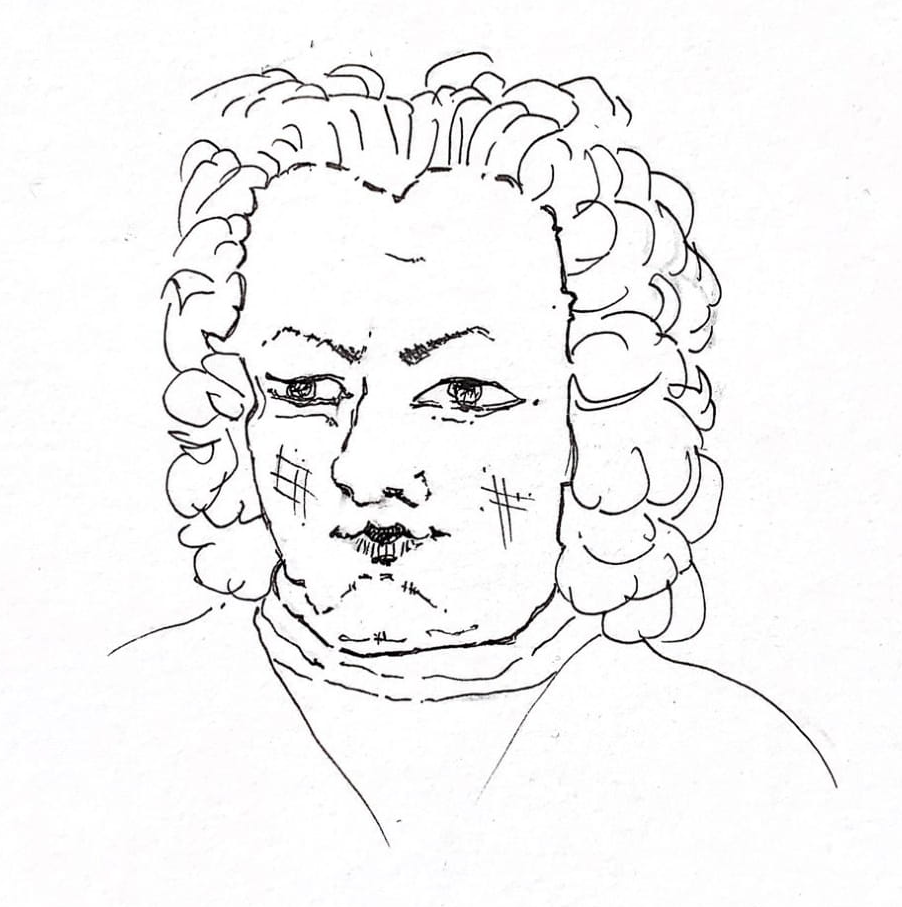‘Subtitled’, Concerto da chiesa’, or church concerto, -normally slow-fast-slow in tempo, as this, leaving aside the recits, is indeed structured, this cantata is, of 6 movements, -opening Aria/Tenor, Recitativo and Choral/Alto, Recitativo/Soprano, Aria/Bass and closing Choral.
The orchestra is modest, but interesting: continuo, with organ, chorus with solo parts, with a combination, of 2 x Flauto-dolce, or recorders, -in the last movement, these combined, with a solo violin, and Oboe da caccia, only appearing in the first and last, tutti, Choral. And the other noteworthy fact is, that, the strings make only two appearances, in movement three and the ending tutti choral.
The central choral, divides this cantata, into 2 equal parts.
1/Aria:
‘My sighs and my tears cannot be counted. If each day is filled with sorrow and misery, they will not stop, and this pain, will lead, to death.’
This text, seemingly, strikes Bach, as a serious statement of sorrow and misery.
This is real pain. The despair of those who struggle with their unbelief.
Without really too much effort or thought, on our part, the substance, of all this, can be heard, in this long and pained, opening threnody, where the distinct and beautifully, haunting sound, of the Oboe da caccia, weaves and wends its way, throughout and about, reflecting, in its sad and sustained song, the wailings and the weeping’s, of this heartfelt text.
The accompiament, for all this, is maintained, solely, by recorders and continuo.
The Bass singer steps in, with a mixture of ritornello material, first heard on recorders, and a transformation of this, into an imitation of actual wailing, -on firstly, the 2 notes, D and C#, then E and D and finally F and E, and then G. d
He dutifully, picks out his key words,
‘…tears…’, 21, and
‘…pain…’, 38.
The middle section adds,
‘…sorrow…’ and
‘…lamentation…’ with,
,…verschwindet…’, ‘vanish’,
in its negative sense, getting a more than fair share of wail-time.
We are left with the impression, that the orchestra and the singer, are in agreement, equally, with the depth of pathos, within, this text.
2/Recitativo:
‘My dearest God, -who allows me, to keep on calling to Him.
But, it is all a waste of time. In my weeping, there is still, no comfort.
The approaching hour can be seen, in the distance. But, even so, I must still try to ‘keep-up’, my pleading-praying.’
This very short secco recit, distinguishes itself, for two reasons:
Firstly, the memorable setting of,
‘My dearest God,…’
and the extraordinarily daring accompiament, -almost an arioso section and definitely extremely chromatic, that Bach sets-up, for,
,…flehen…’ or pleading.
3/Choral:
‘God, who has promised to help me, at all times, now lets Himself, in my sadness, be sought-out, by me, -but without success.’
Will he be cruelly be angry with me, for ever? Can He not, and will He not, have mercy on the poor, like He used to?’
The strings now make their awaited appearance, with the choral melody sung by the Alto voice, reinforced with Oboe and recorders.
The opening string quavers, with semiquavers, although joyous and up-beat, are, nevertheless ambiguous, in their two-timing, rather reflecting the perceived ambiguous relationship, with The Saviour, that this singing soul seems to hold.
And this ambiguity continues throughout, setting up a sort of ‘not-knowing’ and an insecure environment.
Liten for the D# in an otherwise rather sterile viola part, at 33,
– ‘…will He be cruelly angry with me, forever?’
and the Eb/E natural uncertainty, 42
‘…will He, or will He not, have mercy, on a poor-one, like me?’
4/Recitativo:
‘My sorrow is increasing, robing me of rest. My cup of trouble, is filled with tears, and my distress, -that leaves me devoid of feeling, will not be comforted. This night, of grief and sorrow, oppresses my heavy heart. Therefore, I sing, only songs, of grief.
But, no, my soul.
Take comfort, in your destress. God can easily, turn bitterness into joyful wine, and grant you many delights.’
Bach allows this dramatic-secco to rise and fall, according to the text, all proceeding, and leading up to, as you might expect, up to ‘…songs of grief.’
The second half, almost tips over, into an Arioso sentiment, as we hear,
‘comfort in distress’, then,
‘easily turn’, then the
‘bitterness, into wine’,
and finally,
‘the joys, without number.’
5/Aria:
‘Moaning and pitiful weeping, does nothing, to ease sorrow’s sickness.
Whoever looks, towards heaven and seeks comfort there, a joyful light will appear, in his sorrow.’
This extremely long and seemingly drawn-out musical experience, is the moan, the sorrow and the pity.
Characterised by semitones, augmented 2nds, diminished 5ths and 7ths, in both the solo part and the accompaniment, it weeps and laments along, on its contorted and painful way.
The long ritornello seems to naturally separate itself, into two halves, each reflecting the two halves of the text, sorrow’s sickness, followed by that heaven sent, beam of joy.
Of course, the most noticeable characteristic, that we hear, is the unique colouration, of the solo obbligato, an eerie combination, of violin and recorders. This, pitted against a Bass voice, creates a whining sound world, that surprisingly and successfully reflects, this stark, yet redemptive text.
6/Choral:
‘Soul, be true to yourself. Trust in Him alone, who has created you. Whatever may happen, your father, in heaven, always knows, the right thing to do.’
This well known choral, is notable, only for its superb harmonisation.
But please notice, at 11 through 12, the rhythm, -2 x quaver, crochet, which is passed, antiphonal-like, starting with Alto voice, through all voices, except the choral-tune singing Sopranos.
‘
